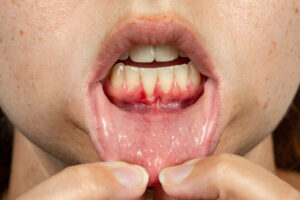Mandibular Tori Symptoms

Key Takeaways
- What & Where: Mandibular tori are harmless bony growths that develop on the inside of the lower jaw (mandible), typically near the tongue.
- Common & Usually Harmless: They are very common and most often cause no symptoms whatsoever.
- Causes: Primarily genetic predisposition, but environmental influences might play a role.
- Symptoms (if any): Potential issues include oral discomfort, denture difficulties, rare interference with speech, or challenges to oral hygiene.
- Diagnosis: Easily diagnosed by a dentist through visual and tactile examination. X-rays may be used for more detailed assessment.
- Treatment: Generally requires no treatment unless symptoms occur. If needed, tori can be surgically removed.
- Routine Checkups Matter: Tori are often discovered during dental exams, so maintaining regular checkups is important.
Table of Contents
What Is Torus Mandibularis (Mandibular Tori)?
What is Torus Mandibularis?
- Location Specificity: Torus mandibularis specifically develops on the lingual aspect (tongue side) of the mandible, typically above the attachment of the mylohyoid muscle, a muscle involved in swallowing and floor-of-the-mouth movements.
- Differentiating from Similar Growths: It’s important to distinguish torus mandibularis from other similar bony growths in the mouth. A related condition called torus palatinus occurs as a midline growth on the hard palate (roof of the mouth).
Characteristics:
- Slow Growth: Tori grow very slowly over time and may eventually stop growing altogether.
- Variation Among Individuals: Individuals may have one torus on either side of the jaw or several bumps forming a larger mass. Their variations in size and shape highlight the individual nature of these growths.
Causes:
- Genetic Predisposition: Studies indicate a clear familial tendency, meaning if members of your family have tori, you have an increased likelihood of developing them as well.
- Environmental Influences: While genetic predisposition plays a primary role, scientists are investigating other potential contributing factors. These might include a high-calcium diet or specific mechanical stresses placed on the jawbone.
Treatment:
- Monitoring: In most cases, dentists recommend regular monitoring of tori to observe any changes in their size or associated symptoms.
- Surgical Removal: The surgical procedure to remove tori is usually performed under local anesthesia. It involves making an incision in the gum tissue, carefully removing the excess bone, and then suturing the tissue back in place. Recovery time is typically quick. Read more: Mandibular Tori Removal
What are the symptoms of torus mandibularis (mandibular tori)?
The vast majority of people with mandibular tori have no symptoms whatsoever. The growths are often discovered during routine dental exams.
Potential Symptoms Associated with Larger Tori:
- Oral Discomfort: Tori can rub against the tongue or the inside of the cheek, causing irritation or a feeling of soreness or tenderness. In some cases, this might lead to ulceration (open sores) in the affected areas.
- Difficulty with Dentures: Large tori can make it challenging to achieve a proper denture fit. They can cause pressure points, leading to ulcers, or they might make dentures feel loose or unstable, affecting eating and speech.
- Challenges with Oral Hygiene: Tori located close to the teeth may make brushing and flossing difficult in those areas. This could lead to a buildup of plaque and bacteria, increasing the risk of gum disease or tooth decay.
- Speech Impediment (Very Rare): In extremely rare instances, very large tori might interfere with normal tongue movement during speech, potentially causing slight speech difficulties.
- Cosmetic Concerns: While not a direct health concern, some individuals with noticeable tori might feel self-conscious about their appearance.
How are mandibular tori diagnosed?
Here’s a detailed breakdown of how mandibular tori are diagnosed, including the different methods used and what you can expect:
Diagnosis Process
- Visual and Tactile Examination: In most cases, a dentist or oral surgeon can easily diagnose mandibular tori through a routine oral exam. They will visually inspect the inside of your lower jaw and feel for any hard, bony protrusions along the gum line.
- Dental X-rays: If there’s any uncertainty, or to assess the size and extent of the growths in more detail, dental X-rays may be taken. These images clearly visualize the bone structure and confirm the diagnosis of mandibular tori.
- Advanced Imaging (If Necessary): In rare cases where there is a concern about a different underlying condition, or if tori are causing significant problems, advanced imaging techniques like a Computed Tomography (CT) scan might be recommended. CT scans provide detailed cross-sectional images of the jaw, aiding with diagnosis and treatment planning.
Ruling Out Other Conditions
While mandibular tori are generally straightforward to diagnose, it’s important to rule out other potential causes of bony growths in the mouth, such as:
- Exostoses: Similar bony overgrowths, but often located more towards the outer surface of the jawbone.
- Tumors or Cysts: In rare cases, growths within the jawbone might require further evaluation to rule out more serious conditions.
What to Expect During a Diagnosis
The diagnosis of mandibular tori is typically a quick and painless process during your dental checkup. Here’s what you can expect:
- Medical History: Your dentist will ask about your symptoms (if any) and your family history of similar growths.
- Visual Examination: They will carefully examine the inside of your mouth, looking for bony bumps.
- Palpation: Your dentist may gently feel the area to confirm the hardness of the growths.
- X-rays: If needed, they will likely take simple dental X-rays for further clarification.
How Can I Detect Symptoms of Dental Tori?
How to Identify Potential Symptoms:
- Look for Bumps: The most noticeable sign is the presence of bony bumps on the inside of your lower jaw. Gently run your tongue along the gum line below your teeth. If you feel hard, smooth protrusions, they might be mandibular tori.
- Discomfort or Tenderness: Notice any feelings of irritation, soreness, or tenderness along the inside of your lower jaw, especially areas near hard bumps. This may become more apparent during eating or talking.
- Ulcers or Sores: Keep an eye out for any open sores or ulcers in your mouth, particularly near any bony growths.
- Difficulty with Dentures: If you wear dentures, be aware of any difficulties with fit, increased instability, pressure points, or sores within your mouth.
- Speech Changes (Rare): Rarely, very large tori might slightly interfere with tongue placement during speech. Pay attention to any subtle changes in your ability to articulate words clearly.
When to See Your Dentist:
- Noticeable Bumps: If you identify hard bumps on the inside of your lower jaw, even without any discomfort, it’s good to get them checked by your dentist.
- Any Discomfort or Unusual Sensations: If you experience any of the symptoms described above, schedule an appointment for a proper evaluation.
- Denture Problems: If you suspect your tori are interfering with the fit or function of your dentures, consult your dentist for solutions.
- Routine Checkups: Even if you don’t currently have symptoms, tori are often discovered during regular dental checkups, so maintain your regular cleaning and examination schedule.
How Do I Know If I Have Mandibular Tori?
- Visual Check: Open your mouth wide and look in the mirror at the inside of your lower jaw, just above where the floor of your mouth meets your gums. Look for any bony bumps or protrusions.
- Tactile Check: Gently run your tongue along the inside of your lower jaw, below your teeth and above your gumline. Feel for any hard, smooth bumps.
Important: If you notice any irregularities in your mouth, even if they don’t cause immediate discomfort, schedule an appointment with a dentist for proper diagnosis.
FAQ on Mandibular Tori Symptoms
What age does mandibular tori start?
They typically begin to form around the ages of 20 to 30, though they can sometimes appear earlier or later in life. The growths are often slow and may stabilize by the age of 40. While generally harmless, they can occasionally cause discomfort or interfere with dental procedures.
What causes mandibular tori to grow?
The exact cause of mandibular tori is unknown, but it’s likely a combination of factors. Genetics play a significant role, so if you have family members with these growths, you’re more likely to develop them. Teeth grinding or clenching can also contribute, and some evidence suggests bone density or even certain dietary habits could be involved. Read more: Mandibular Tori Vitamin Deficiency
What can be mistaken for mandibular tori?
Other bony growths like osteomas, soft tissue growths like fibromas, fluid-filled cysts called mucoceles, and less common cartilage-containing growths called osteochondromas can sometimes be mistaken for mandibular tori. It’s important to have any unusual growth in your mouth checked by a dentist or doctor to receive an accurate diagnosis.
Is mandibular tori caused by stress?
While stress alone doesn’t directly cause mandibular tori, it can contribute to factors that may increase their likelihood. Stress can lead to teeth grinding or clenching (bruxism) which puts strain on the jawbone and may stimulate bone growth. Additionally, the overall genetic predisposition for tori remains a primary factor.
What are the complications of mandibular tori?
Most of the time, mandibular tori don’t cause any problems. However, in some cases they can lead to complications like difficulty fitting dentures, speech impediments if they interfere with tongue movement, discomfort while eating, or increased difficulty with oral hygiene leading to gum issues.
Can Tori become cancerous?
No, tori (both mandibular and palatal) are benign bony growths and cannot become cancerous. They also don’t increase your risk of developing cancer. Read more: Early Stage Mandibular Tori Cancer
Fact Checked
Our dedicated team rigorously evaluates every article and guide to ensure the information is factual, up-to-date, and free of bias.
Updated Regularly
We update our articles and reviews regularly to ensure you have access to the latest data in the dental industry.
The content on Dental3DU’s blog is intended for educational purposes only. This information should not be relied upon as professional medical counsel. Be sure to always consult with your dentist about the dangers and benefits of any medication, treatment or procedure.







